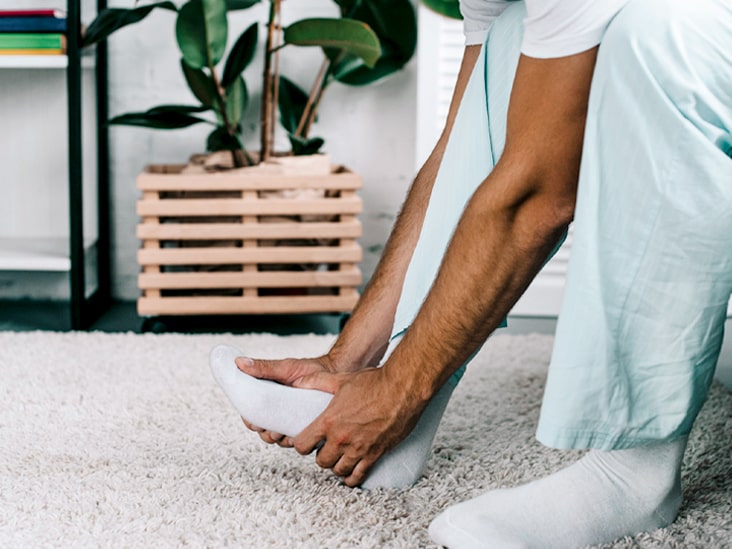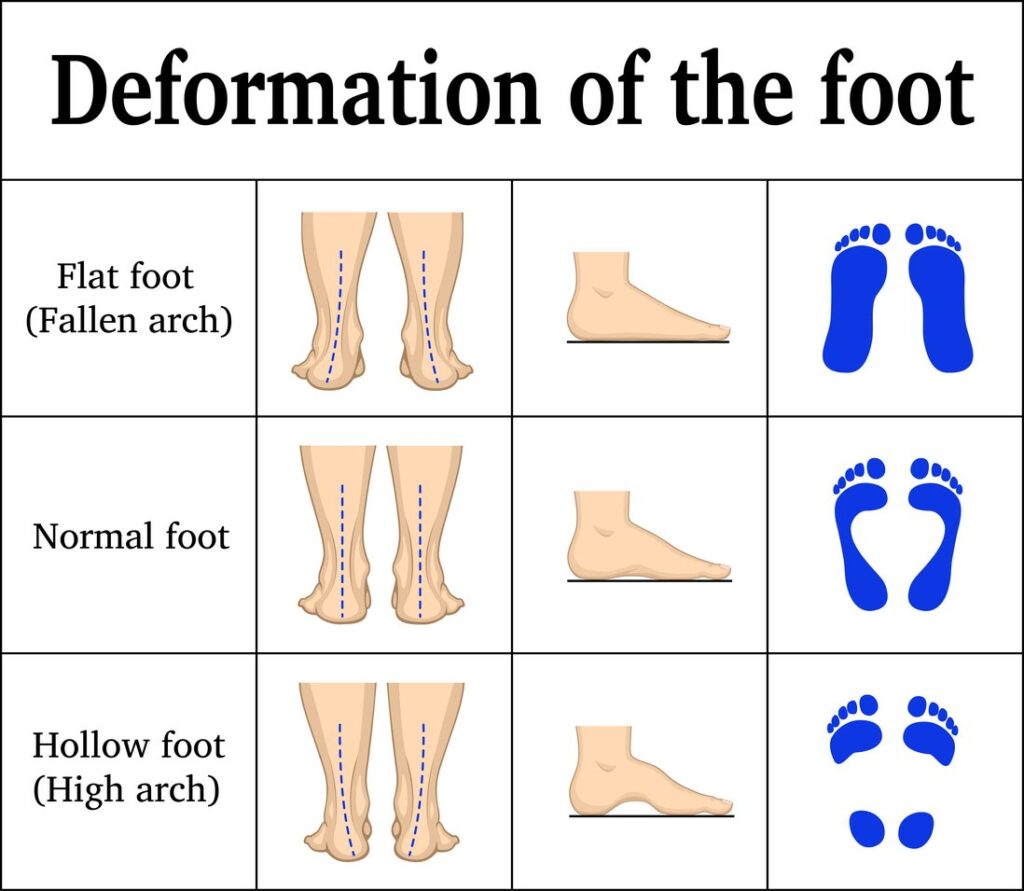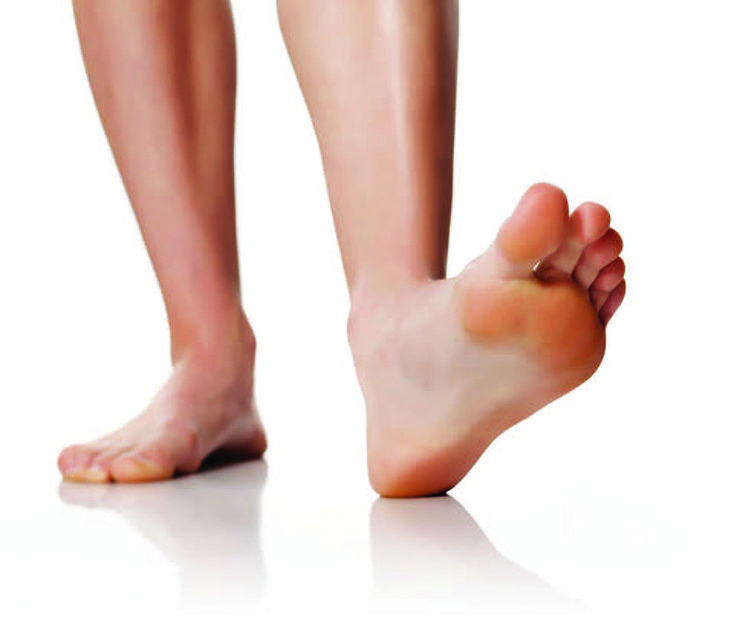WHAT IS FLAT FOOT?
Your foot has an upward curve in the middle from the inside called an arch. However, some people don’t have an arch and the entire sole of your foot touches the ground when standing. This is referred to as flatfoot, pes planus, pronated foot, or fallen arches.
It is characterized as a deformity with various degrees of physical impact. This condition impacts one or both feet. This is usually passed down as a hereditary trait or might develop over time.
Babies are born with flat feet and the arches typically form by age 6. Sometimes the arches collapse in adults. This condition is referred to as fallen arches.
Flat feet usually do not cause problems for most people. But, if flat feet cause pain or other problems, treatments are helpful.

WHAT ARE THE TYPES OF FLAT FOOT?
Flat feet cause problems after childhood or gradually develop over time in adulthood. The various type of flat foot condition include:
- Flexible: It is the most common flat foot condition. The arches in the feet are visible when you aren’t standing, but disappear when you put weight on the feet. The tendons and ligaments in the arches could stretch, tear and swell causing pain and related symptoms. It mainly occurs during childhood or the teen years affecting both feet and might gradually worsen with age. Tendons and ligaments in the arches of the feet can stretch, tear and swell.
- Rigid: There are no arches when standing or putting weight on the feet and sitting or no weight on the feet that would cause foot pain. It would develop during the teen years and worsen with age. This causes difficulty to flex the feet up and down or move them side-to-side.
- Adult-acquired (fallen arch): The foot’s arch unexpectedly drops or collapses. The foot turning outward causes painful conditions affecting only one foot. Inflammation or a tear in the leg tendon (posterior tibial tendon) that supports the arch is the main cause.
- Vertical talus: Birth defect (congenital disability) in babies known as vertical talus prevents arches from forming. The talus bone in the ankle is in the incorrect position. It is also known as rocker-bottom foot as the bottom of the foot resembles the bottom of a rocking chair.

WHAT CAUSES FLAT FOOT?
A human foot contains 33 joints holding 26 different bones together. It also contains more than 100 muscles, tendons, and ligaments. Some people develop high arches, while others might have very low or nearly absent arches, causing flat feet. Flat feet are mostly passed down from parents as it is present in your genes. It might also develop gradually over a period of time. Some of the major cause of flat foot include:
- Genetic factors
- Weak arches, as the arch is visible when a person sits and flattens when they stand
- Foot or ankle injury
- Arthritis of rheumatoid arthritis
- Damage, dysfunction, or rupture of the posterior tibial tendon
- Other factors such as pregnancy, aging and obesity
- Nervous system or muscle diseases, like cerebral palsy, muscular dystrophy, or spina bifida
- Certain medical condition increase your risk of flat feet, including achille’s tendon injuries, broken bones, cerebral palsy, Diabetes, down syndrome, high blood pressure

WHAT ARE SYMPTOMS OF FLAT FEET?
Pain is the most common symptom of flat feet caused mainly due to strained muscles and connecting ligaments. Abnormal stress on the knee and hip results in pain in your joints causing the ankles to turn inward.
- Leg cramps
- Muscle pain (aching or fatigue) in the foot or leg
- Pain in the arch, ankle, heel or outside of the foot
- Pain when walking or changes in your gait (how you walk)
- Toe drift (front part of the foot and toes point outward)
You can test yourself to see if you might have flat feet. Follow these three steps:
- Wet your feet
- Stand on a flat surface to see your footprint
- Step away to look at the prints.
Complete imprints of the bottom of your feet on the surface indicates you’re likely to have flat feet. Many young children suffer from flexible flat feet meaning when the child stands, the feet look flat. However, when the child rises to their toes, a slight arch would appear. The children grow older and the arches develop.
HOW TO DIAGNOSE FLAT FOOT?
It is important to seek medical care in below cases including:
- Flat feet developed recently.
- Pain in the feet, ankles, or lower limbs.
- Symptoms don’t improve with supportive, well-fitted shoes.
- One or both feet becoming more flat
- Feet feeling rigid, stiff, heavy, and unwieldy
Doctor would look at your medical history as well as recommend imaging tests such as an X-ray, CT scan, or MRI scan.

HOW TO TREAT FLAT FOOT?
If you are suffering from flat feet, you don’t have significant problems or require treatment. Your doctor would recommend nonsurgical treatments to cure the foot pain, stiffness or other related issues. Rarely, you might require surgery to fix rigid flat feet or problems with bones or tendons.
Treatments include:
Pain relief medicines such as non-steroidal anti-inflammatory drugs (NSAIDs) such as ibuprofen
- RICE therapy including rest and ice to ease inflammation and pain.
- Physical therapies to stretch and strengthen tight tendons and muscles, improving flexibility and mobility.
- Supportive devices: Such as foot orthotics, foot or leg braces and custom-made shoes to relieve pressure on the arch and reduce pain if the feet roll too far inward.
Wedges into their footwear provide relief if you have posterior tibial tendonitis along the inside edge of the orthotic. This helps relieve the load on the body on the tendon tissue. An ankle brace is beneficial to reduce the inflammation.
In case of severe pain or foot damage your doctor would recommend surgery such as:
- Arthrodesis: Fusing foot or ankle bones together
- Excision: Removing bones or bony growths called spurs
- Osteotomy: Cutting or changing the shape of the bone
- Synovectomy: Cleaning the tendons’ protective coverings
- Tendon transfer: Addition of tendon from other parts of your body to your foot to help balance the pull of the tendons and form an arch
- Lateral column lengthening: Grafting bone to your foot making the arch rise more naturally
OUTLOOK
Flat feet or fallen arches develop during your teen or adult years. Flat foot might lead to pain and difficulty walking. Flat feet affect the alignment of your body while standing, walking, or running. This could increase the possibility of pain developing in the hips, knees, and ankles.
You should seek medical advice if you are suffering from flat feet. Non-surgical treatments including stretching exercises and orthotics would ease pain and inflammation. Surgery is the last option and opted on in rare instances.
If you or anyone you know is suffering from foot problems, our expert providers at Specialty Care Clinics will take care of your health and help you recover.
Call us on (469) 545-9983 to book an appointment with our specialists.
